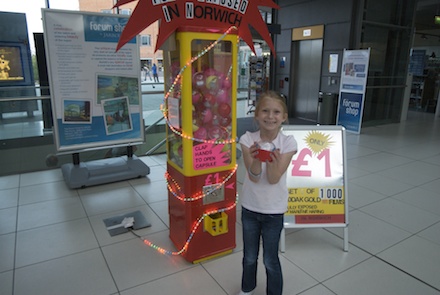
Text by Ursula-Maria Probst and Anthony Auerbach published in Photo-ID: Photographers and Scientists Explore Identity edited by Keith Roberts (Norwich: Norfolk Contemporary Art Society, 2009)
Marlene Haring’s Choosing is Losing
In her book of essays On Photography the critic Susan Sontag begins by suggesting how the photographic image influences our understanding of the world as subjects, and goes on to show how social and cultural identity are co-constructed through photography. The work of Marlene Haring suggests a comparable approach to identity and politics. She combines media art and performance as a critical interventionist. She inserts subjective artistic action in social and cultural situations, disclosing the fissures and gaps in the identity system, as well possible new spaces of communication and networks of relations.
Marlene Haring’s Photo-ID project, Choosing is Losing, takes photography for a walk. Her rambles approach the city of Norwich, repeatedly, from its margins. On the way, she shoots 1,000 rolls of film with her Nikon F100 SLR camera, producing 24,000 images. However, these photographs are not presented as pictures in the context of an exhibition, but are displayed as undeveloped canisters of film in a vending machine. Every day, between seven a.m. and midnight, in the foyer of The Forum in Norwich, by dropping a pound in the machine anyone can acquire a film with 24 exposures and decide whether to develop it or not.
The latency of the images activates a craving for their visibility, although the words of the title, whose rhyming combination entices one let it roll off one’s tongue repeatedly, remind us that making a choice always means losing a potential.
Haring’s performative approach to photography puts the camera in the hands of the flâneuse, whose tracks dissect the city, isolate and identify incidents. By exposing the film, registering the accidents of a dérive, but stopping short of representation — not developing the negatives — Haring highlights and questions the role of photography in constructing the reality from which it extracts its incidents, and, moreover, the role of photography in the construction of meaning for the photographer and the viewer — from the snapshot to the artwork, from documentary and reportage to advertising photography. Indeed, Haring puts the identity of photography — the authority it claims in so far, as Henri Cartier-Bresson supposed, the shutter was released at just in the right moment — in suspense.
It has often been pointed out that events which are known or remembered through photography seem more real than if we relied only on experience or verbal reports. But in a world constructed from a proliferation of images, what contact can be made with reality — subjectively or objectively? By making photography — as a medium of both mass-production and mass-consumption — her own, by reflecting on the ways it constitutes reality and identity, Marlene Haring is ready to shoot back.
The question posed by Photo-ID, how identity is constructed by a complex of gender-, social-, cultural-, economic- and personal determinants and relations, is a thread which gets various twists as it runs through Haring’s work.
The installation Photoboothautograph consists of forty or more self-portraits, each one a two-frame animated video loop, each flickering on a different monitor or projector to its own rhythm. Show Me Yours, I’ll Show You Mine is an invitation to just that. Haring constructed a booth, looking like a giant mirror wardrobe in which the transaction could take place between the artist and the visitor, or between any two individuals who made this pact, entered the space prescribed for it and duly pulled their pants down. Marlene Hairy, or In My Bathtub I am the Captain, was a performance in which Haring, in a full-body, long-blond-haired costume, crawling on all fours, and without a word, led her audience from the academy of art, through a park, through a fun fair, to a vacant shop in a ‘red light’ district of Vienna to pose for a group photo, and thence to her own apartment nearby, where anyone who wanted to talk with the hairy creature had to get into the bath with her. Living in Hope inhabited the outer limits of what could be identified as artistic performance. For three weeks during the Festival of Regions, held this year in the Austrian town of Linz, the artist was a permanent regular in a local pub. Present every day from opening time until closing, doing nothing different from the other regulars (‘living in hope’, according to the AAACME Dictionary, usually suggests holding out a forlorn hope, or being resigned to despair, and thus authorises the traditional remedies for the latter: drinking, gambling, wasting time), Haring’s persistence was witness to the web of interactions, exchange and conflict which constitute the place as social. At the same time as another knot in the web, Haring’s presence was a slight alteration of the situation, enough to produce unexpected communication.
In all these pieces, the process of identification is interrupted or delayed. Likewise, in front of Haring’s vending machine yer pays yer money, yer takes yer choice. The label on the film reads ‘Keep it or develop it!’ and notes the date and time of shooting and the process-by date of the film. The viewer is not yet the viewer. Taking the roll of film out of the machine, he/she has a choice and no choice. The photographs are already taken. Developing won’t change them. Leaving them undeveloped, they will eventually fade. The canister stands for a possible narrative, it is the container of contents: a series of twenty-four incidents on a walk, captured on film. But it’s your choice to send it to the lab, release the images and determine the story.
Does that make the undeveloped negatives a form of documentary photography? On whose choice, Haring’s in shooting the film, or yours in keeping or developing it, should authorship be conferred? What does the machine hand over to the potential viewer for a quid? A document? A fragment of subjectivity? An impossible choice?